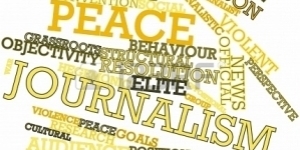Peace Journalism and Conflict Transformation: The Importance of Training
TMS PEACE JOURNALISM, 7 May 2018
Abbas Aroua | Cordoba Foundation of Geneva – TRANSCEND Media Service
Apr 2018 – In addition to its conflict transformation activities on the ground, in the past several years the Cordoba Foundation of Geneva (CFG) has made training one of its strengths. We sincerely believe that promoting peace also means educating young people and training actors in the field. This is all the more effective because the audience is diverse, including actors belonging to the various stakeholders of a given conflict. Under these circumstances, the training venue becomes a real mediation space where the participants, in addition to acquiring technical knowledge, get to know each other, to exchange and to make joint analyses.
In this framework, we offer training in peace journalism, also called ethical, constructive, or professional journalism, which aims to teach a new way of reporting on conflicts in all media. The media and journalists also have a role to play in conflict dynamics and their coverage of events can be counterproductive, harmful and biased, without this necessarily being their original goal. Journalists, and the media more generally, can, if they wish, play an indirect role in the prevention of violence by reporting all narratives and perspectives of the conflict stakeholders, and reporting the positive facts, or highlighting the possibilities of exiting the crisis. These training courses also aim to show journalists the possible consequences of the information that they deliver, as most of them do not necessarily realise it.
Recently, the CFG was asked to undertake a training as part of its project to strengthen social cohesion in Tanzania. In February 2018, it organized a training in Zanzibar bringing together about thirty young journalists and media professionals on the theme of peace journalism. Organized with the support of the Swiss Federal Department of Foreign Affairs and in collaboration with the Friends of Zanzibar association, this training focused on three modules: an introduction to the concepts of peace journalism, approaches to peace journalism, and finally the role of journalists in mediation processes for peace and conflict transformation. Two trainers from the CFG, Lakhdar Ghettas and Abdoulaye Bâ, facilitated this training. The participants, all young journalists (women and men) practice in various local media, such as radio, television and newspapers (news agencies and newspapers) but also in the electronic press.
In the introduction, the basic elements for defining, understanding and analysing the conflict, were presented to the participants. To capitalise on these indispensable tools, young journalists were strongly encouraged to carry out sustained fieldwork, as this would enable them to clearly identify the angles from which it would be useful to approach conflicts, to ensure professional coverage. To achieve this, it is necessary to understand a conflict by going back to its genesis, identifying its main and secondary actors, and determining its causes. Behind the real causes of conflict are always the main and secondary interests. These generally uncloak the actors and highlight the real issues of the conflict, including those that the parties do not express publicly.
With such an approach, journalists would not only be able to do credible information gathering, but also alert society about the nature and risks of conflict, which can lead to violence in society in general. Journalists can raise the alarm bell to highlight the dangers of neglecting conflict causes, letting these evolve from a state of latency to often-destructive escalation. In other words, once the conflict is brought to the fore by good analysis, society becomes aware of a potential threat to peace. It will then be up to its leaders (political, traditional and religious leaders) and local peace actors (civil society activists among others) to anticipate before the conflict erupts and degenerates into violence.
Then, the approach of a journalist facing a conflict situation was discussed. The notions of an objective and balanced coverage, oriented towards a general presentation of the issue and the state of its evolution were explained. Here, it is important to emphasize the way in which the journalist reports the theses, positions and statements of the conflict parties. The terms, words, tone, illustrations and other images used by the journalist should be carefully chosen and thoroughly used. The parties to the dispute should be treated in the same way in dealing with the conflict. For example, the journalist should be forbidden to quote one party in parentheses and to explain, in his own words, the position of another. Such an attitude would give him the impression of having taken sides with the first party in the conflict. The journalist should therefore pay attention to these kind of subtleties, to remain credible in the eyes of those who expect from him an irreproachable professional work.
In all cases, the code of ethics requires journalists to remain equidistant between the conflict parties. Nevertheless, they should not only focus on the causes of the conflict, its consequences and the dramatic toll that results from the violence it engenders. They are also responsible for proposing solutions and focusing on the common interests between the parties. In this way, their work will contribute to demarcating the grounds for a possible mediation effort, which could intervene to bring conflict parties together and to bring them to an agreement able to put an end to the conflict. This option is encouraged because, in the context of constructive journalism, the articles and elements to be disseminated on a conflict should be measured, balanced and always oriented towards calm and peace. From this point of view, the choice of these elements remains a question of primordial editorial choice in the context of peace journalism. The goal of peace journalism is not to make the journalist a “direct actor of peace”. But, by its influence, its presence alongside actors and victims, it can be a real vector of facilitation through its action. By highlighting the positions of the parties, by relaying their needs as well as their interests and by putting forward the voices which call for appeasement and peace, it prepares the bed for a mediation which could have all chances of success.
At the end of the day, examples of “papers” reporting on conflict cases were presented and analysed from the perspective of conflict analysis and peace journalism. Practical exercises in writing news articles, articles and editorials were presented. A proactive exchange of information that could lead to violence and analyses that can help identify avenues for conflict transformation ended the day. In a tense socio-political environment like Zanzibar, “this training has been very useful for us. We will frame everything that we learned during this intense and informative day with our local context. It will be our contribution to alleviating the multiple tensions we are experiencing. Especially with the approach of new elections in our country, “said a young participant.
The trainings provided by the CFG are often a great success, with positive feedback from participants and further training requests. CFG therefore commits itself to continue its necessary work in the regions where it conducts programs to promote dialogue by different means and actors, as a non-violent solution to conflicts. Training journalists in the concepts and techniques of peace journalism, is to promote access to properly established information, to make people understand the causes and issues of conflict, and finally to encourage the participation of society in the peaceful transformation of these conflicts.
__________________________________________
 Abbas Aroua is a medical physicist and adjunct professor at the Faculty of Medicine of the Lausanne University, Switzerland. He is director of the Cordoba Foundation of Geneva for Peace Studies and Convener for the Arab world for TRANSCEND Network for Peace Development Environment.
Abbas Aroua is a medical physicist and adjunct professor at the Faculty of Medicine of the Lausanne University, Switzerland. He is director of the Cordoba Foundation of Geneva for Peace Studies and Convener for the Arab world for TRANSCEND Network for Peace Development Environment.
DISCLAIMER: The statements, views and opinions expressed in pieces republished here are solely those of the authors and do not necessarily represent those of TMS. In accordance with title 17 U.S.C. section 107, this material is distributed without profit to those who have expressed a prior interest in receiving the included information for research and educational purposes. TMS has no affiliation whatsoever with the originator of this article nor is TMS endorsed or sponsored by the originator. “GO TO ORIGINAL” links are provided as a convenience to our readers and allow for verification of authenticity. However, as originating pages are often updated by their originating host sites, the versions posted may not match the versions our readers view when clicking the “GO TO ORIGINAL” links. This site contains copyrighted material the use of which has not always been specifically authorized by the copyright owner. We are making such material available in our efforts to advance understanding of environmental, political, human rights, economic, democracy, scientific, and social justice issues, etc. We believe this constitutes a ‘fair use’ of any such copyrighted material as provided for in section 107 of the US Copyright Law. In accordance with Title 17 U.S.C. Section 107, the material on this site is distributed without profit to those who have expressed a prior interest in receiving the included information for research and educational purposes. For more information go to: http://www.law.cornell.edu/uscode/17/107.shtml. If you wish to use copyrighted material from this site for purposes of your own that go beyond ‘fair use’, you must obtain permission from the copyright owner.
Read more
Click here to go to the current weekly digest or pick another article:
TMS PEACE JOURNALISM:
